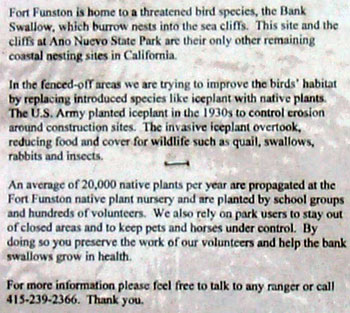Editorial: The Non-Empirical's New Close
There are meetings, protests , the lawsuit. They're all smart moves which I support. But what seems missing to me is any way that works for people to be involved in the decision-making process. Most people don't have the time, energy or knowledge to find out when and where decisions are made and feel excluded from even trying.
Several people have put forward some interesting alternative explanations of how one thing affects another at Fort Funston. Things aren't always obvious, and a lot of assumptions are left unchallenged. Solutions to problems, which sometimes are not even clearly problems ("if it ain't broke, don't fix it!"), often don't seem to have a sound scientific basis. Where is the empirical evidence? So many untested theories seem to be flying about that I'm afraid the bank swallows might crash into them! For instance, it's been taken as truth that dogs somehow "bother" bank swallows; that the birds will be too hassled somehow to reproduce or feed their young. Could it be, a dog owner suggested yesterday, that in fact there's something about off-leash dogs (perhaps that the dogs scare away not the bank swallows but their predators such as cow-birds) which is the reason the swallows choose, out of many coastal bluffs, Fort Funston? I have no idea, but it's an interesting thought that makes as much sense to me as the idea that a few dogs have the power to bring down a colony of birds flying 40 feet overhead. This website is a place for looking at questions, assumptions, experimental evidence and solutions -- with an open mind.
Below is an idea sheet to begin looking at the issues raised in the two signs posted on the fence this week. I've broken the sentences into segments, because each segment is a topic worthy of discussion, problem-solving, testing and decision-making. What do you think? Click over to the two-page printer version and grab a pencil. Are there things you'd like to be convinced of before assuming that the policy makes sense, or will even work?
I don't want this site to be a launching pad for verbal attacks on the Park Service administration or employees. I don't think theirs is an easy job, and they have to act within constraints from above as well as deal with multiple constituencies. If anything, I am trying to help them in the task of making sense out of the options at Fort Funston. So please e-mail ideas, but try to refrain from name-calling and sarcasm. The anger is justifiable, but it will only antagonize both sides further. I just want to see the evidence, the science backing up some of the decisions being made, and open up a discussion about how to balance the various activities and groups at Fort Funston. Thanks for visiting the site today. Have a great weekend, and may the Fort be with you!
- Michael B. Goldstein, Editor


Fort Funston Idea Sheet
What are your thoughts, questions, solutions for the issues raised in the signs posted on the fence?
click here -- jump to two-page version for printing
| Why the Fences? | |
| Fort Funston is home to | |
| a threatened bird species, the Bank Swallow, | |
| which burrow nests into the sea cliffs. | |
| In the fenced-off area we are trying to improve the birds' habitat | |
| by replacing introduced species like iceplant with native plants. | |
| The U.S. Army planted iceplant in the 1930's to control erosion around construction sites. | |
| The invasive iceplant overtook, | |
| reducing food and cover for wildlife such as quail, swallows, rabbits and insects. | |
| An average of 20,000 native plants per year are propagated at the Fort Funston native plant nursery | |
| and are planted by school groups | |
| and hundreds of volunteers. | |
| We also rely on park users to stay out of closed areas | |
| and to keep pets and horses under control. | |
| By doing so you preserve the work of volunteers | |
| and help the bank swallows grow in health. | |
| For more information please feel free to talk to any ranger | |
| or call 415 239-2366. Thank you. | |
| Seasonal Use Area. Until further notice, | |
|
this area shall be open from approximately mid-August to mid-March. |
|
|
It will be closed when the bank swallows return here to raise their young in the springtime. |
|
| Bank swallows (Riparia riparia) are a state-threatened species in the state of California | |
| and are protected by the Federal Migratory Bird Treaty Act of 1960. | |
| National Park Service rangers will re-open the gates to allow access into this area | |
| when the bank swallows have left Fort Funston for their southern migration in late July or August. |
To
First Section of Fort Funston Forum